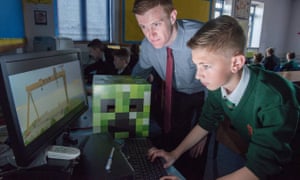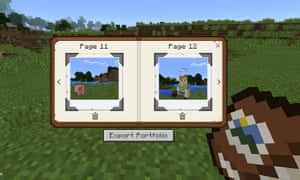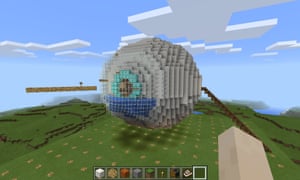Minecraft Education Edition: why it’s important for every fan of the game
Microsoft has been demonstrating its new schools version of the blockbuster, but crucially this spin-off could break off from the original Minecraft modding community

At the densely crowded Bett show, a mammoth education technology conference taking up most of London’s ExCel venue, a vast audience has gathered to watch one particular demonstration.
It is Microsoft’s newly announced Minecraft: Education Edition, a special version of the hugely successful building sim, specifically customised for the classroom environment.
As the company representative highlights the main features, spectators photograph every single powerpoint slide. Behind the stage there’s a demo area with dozens of laptops running an early version of the new edition – all lined up on tables designed to resemble the game’s simple wooden blocks.
There is a constant throng of excitable children, all desperate to play. Minecraft is a big attraction and Microsoft knows it.
Just a week before Bett, the company announced that it had purchased MinecraftEDU, an educational version of the game, which was already being used in hundreds of schools all over the world. That product was designed and distributed by a small Finnish-American outfit, TeacherGaming, and while Microsoft says it won’t shut EDU down, the game won’t be receiving any new updates or support.
Minecraft: Education Edition will effectively be a replacement, developed in-house at Mojang in cooperation with a team at Microsoft’s Redmond campus. The new product features a complete version of Minecraft Windows 10 Edition, the refreshed version of the main game released as a beta last year, but adds extra functionality for teachers.
There is, for example, a better in-game map – now called the Locator Map – which, when a class is playing together in a shared Minecraft world, lets everyone see exactly where everyone else is and what they’re doing – handy for teachers who want to keep a close eye on wayward pupils.
Also useful for guiding activities in the world are two new teacher-only controls: Build Deny and Build Allow. The former is an invisible block type that can be placed around a model to stop pupils modifying it – it’s designed to stop the sort of vandalising and trolling that can ruin multiplayer classroom building sessions.
It could also be used to restrain building projects, requiring students to work within more confined spaces and thereby think more carefully about construction space and impact.
The new game also adds a camera to the inventory. This allows children to quickly and easily take photos and videos of their projects, or even put the camera on a tripod to take selfies. Subsequent images are automatically placed in a zip file which downloads to their desktops – and to their teacher’s machine.
It is, according to Microsoft, more intuitive and adaptable than using the Print Screen function, and also allows teachers a better method of assessing student work.

So what will this work actually entail? Schools have already been using Minecraft for several years in a variety of projects. The game includes elements of building, farming, mining and engineering, so teachers have used it to explore everything from architecture and physics to ecology, sustainable agriculture and history.
During the Bett presentation, Microsoft showed how a school in Scotland got children to redesign Dundee’s waterfront area in Minecraft, while sixth grade pupils at a school in Seattle used the game to model a river and learn about its ecosystem by damming the flow in different locations.
“Some of the simulations we’ve seen are incredible,” says Deirdre Quarnstrom, who’s heading up the Education Edition project at Microsoft, after three years as chief of staff on Xbox. “We saw one school building a simulation of the great fire of London. Children were able to use TNT to blow up one of the houses in the middle to start the fire – it gave them the chance to see the enormity of it.
“One thing we often see is students building a representation of their school in Minecraft. They need to go out of the classroom, measure and estimate, and work out who’s going to build the cafeteria, the gym, the science lab … what materials they should use – it requires collaboration and a bunch of different skills, including maths, art and design.”
The aim with the Education Edition, she says, is to continue the work of MinecraftEDU, but to simplify the process and gradually add functionality. A key element is the fact that the new version features a more robust peer-to-peer server infrastructure, which means any laptop in the classroom can run an online Minecraft world that all the other students can join – the school doesn’t need to buy and maintain a dedicated server computer, which can be costly and complicated.
MinecraftEDU could use peer-to-peer networking as well but it wasn’t straightforward and without technical staff on-hand some teachers found it intimidating.
Microsoft has also set up a dedicated Minecraft Education website, where it is sharing projects and class plans, as well as educational maps, which can be downloaded to the classroom. Students can access the game using an Office 365 login, which means they’re also able to work on projects from home (it’s also possible to import and export map files between the Education and Windows 10 editions).

Microsoft is keen to stress you don’t need to log in through Office, but many schools already use the application and it means they don’t have to come up with a new bunch of passwords.
However, the mere mention of Office 365 implementation is sure to worry some Minecraft fans and industry observers, who have been twitchy about Microsoft’s plans for the game since the company’s $2.5bn purchase of Mojang in 2014.
There was a great deal of controversy last year when it was revealed that theWindows 10 Edition of Minecraft was written not in the accessible programming language Java, like the original version of Minecraft, but in C++.
This made it compatible with the Pocket version of the game, which runs on smartphones and tablets, but – and this is important – made it incompatible with the absolutely vast collection of community-made mods, maps, skins and mini-games that have orbited Minecraft since its inception.
What concerns the community is that fans will no longer be able to make and share their own Minecraft modifications if the C++ version of the game completely replaces the Java version.
“I don’t think it’s far-fetched at all to speculate that Microsoft would like the Windows 10 C++ edition of Minecraft to supplant the current Java edition in the future, and there are reasons to both be excited and worried by this,” says experience modder Daniel Ratcliffe.
“For the PC Minecraft community, the biggest worry is compatibility between versions: right now, there is none. If Microsoft are smart, they’ll try to make worlds, resource packs, and skins created for the old version be loadable in the new, as these don’t involve actual code. But compatibility of current mods, which feature custom Java Code that changes the actual behaviour of Minecraft, is out of the question. Fundamentally, Java code that relies on the old codebase isn’t going to work against a new language.”
Conspiracy theorists suggest that Microsoft may be intentionally blocking community content so that it would be able to sell its own mods, maps and skins – as it has been able to do with the console versions of the game, which don’t easily support unofficial add-ons.
On the Minecraft forum on Reddit, reactions to the Windows 10 announcementwere so vociferous that Mojang’s Tommaso Checchi had to wade in and assure fans that, although he thought it would be cool to have one unified version of the game, running in the C++ language (due to better performance and a common codebase), the company had no immediate plans to make that happen.
But here’s the interesting thing – Minecraft: Education Edition is also written in C++. This is the version of the game that’s going to be in classrooms around the world, and which may well become the way in which thousands of children first experience the game.
They won’t even have to buy it – they’ll be able to log into their school version from home. It’s clear that, although Microsoft may not be on the verge of phasing out the legacy Java version of the game, all its current thinking is toward C++.
However, Quarnstrom is keen to stress that the community is going to be an important part of making Education Edition a success. Microsoft won’t be building all those maps and projects for its website – it’ll be relying on educators to upload their own experiments; including those who have spent years developing assets for the Java-based MinecraftEDU.
“We want to start bringing the community in. We have some great ideas, but we’ll never be able to beat the collective creativity of the community. Our goal is to create a world library. We had a site open before we really started talking about the product, and 5,000 people have registered already,” says Quarnstrom.
”We have great connections with the early adopters who were using MinecraftEDU in the classroom – we’ve been talking to them. We’re just trying to work out the right level of support and resources, we don’t want to just tell people how to play Minecraft, but we want to break down the barriers.”
Minecraft: Education Edition is launching this summer with a subscription fee of $5 a user. It looks like a well devised package offering plenty of classroom-specific functionality, without restraining creative freedom and with greater accessibility than MinecraftEDU. The children at Bett were quick to work with friends, setting up their own mini-servers and messing around on quick projects.
The project also provides an interesting test case for the entire future of Minecraft. It represents another C++ iteration of the game, and through its interaction with the Windows 10 edition is likely to become the main platform for a new generation of fans. However, Education Edition is also going to rely on a big community of users willing and able to start sharing their resources – and a lot of the key talent grew up on the Java game.
To move ahead without alienating a vast and highly engaged fanbase, Microsoft is going to have to build some kind of API (application program interface) that will give the game’s creative community access to the C++ versions of the game. “An officially supported API, if written properly, would have many advantages over the current system,” says Ratcliffe. “Mods would be easier to install, compatible between updates and platforms, and could be properly sandboxed, safely allowing things like mods that automatically download when you connect to servers. To achieve this, I imagine mods would written in some kind of scripting language, rather than C++ itself.”
It will also have to think about a way to convert the gigantic back catalogue of fan-made maps, mini-games and skins onto the new platform – even if more complex mods written in Java would never be compatible.
With declines in other areas of its software business, Minecraft is a vital prize for Microsoft – but it is also a fragile one. “My dream would be to see an official marketplace for mods, browsable in-game or via the Microsoft Store,” says Ratcliffe about the move toward a unified C++ edition. “This would allow authors to make revenue from their mods and work on them full time, raising the quality of content. Microsoft would have to be careful, however: Valve were hit by a massive user backlash when they tried to build a similar system on Steam Workshop this summer.”
Clearly then, community is vital: what happens with Education Edition, the coalface of Microsoft’s engagement drive, should be keenly watched by all fans of the game.
Minecraft Education Edition: why it’s important for every fan of the game